
Looking for How to Make Peach Honey or Nectarine Honey - Easily! in 2025? Scroll down this page and follow the links. And if you bring home some fruit or vegetables and want to can, freeze, make jam, salsa or pickles, see this page for simple, reliable, illustrated canning, freezing or preserving directions. There are plenty of other related resources, click on the resources dropdown above. If you are having a hard time finding canning lids, I've used these, and they're a great price & ship in 2 days.
If you have questions or feedback, please let me know! There are affiliate links on this page. Read our disclosure policy to learn more.
How to Make Peach Honey or Nectarine Honey - Easily!
How to Make Homemade Peach or Nectarine Honey - Easily!
For more information about stone fruits, see Peach Picking Tips
And for a variation, using peach mango juice, see this page on blogspot!
See this page for blueberry
jam, this one for fig jam and
for berry jams, see strawberry,
blackberry, raspberry jam For easy applesauce or
apple butter directions,
click on these links. I've got some other pages for specific types of
jam and butters, too, see this page.
Ingredients
- 8 cups peach juice (either fresh, from washed, sound pieces and
peelings from fruit used for preserves, pickles, etc - OR canned
peach juice)
NOTE: the juice will boil down a LOT - so I suggest using or adding peeling and pureed peach fruit. - 6 or 7 cups of water - if you are starting with peelings, you will need the water to cook them in.
- 4 cups sugar or Stevia (in a prepared form like Truvia, it measures same as sugar; if you use another form, you will need do your own conversion) - or Splenda, if you prefer, , Stevia or 3 cups of bee honey! (Sugar or honey work best; Stevia (in a prepared form like Truvia, it measures same as sugar; if you use another form, you will need do your own conversion) - or Splenda, if you prefer, /Stevia don't allow it to thicken very well, you will have to boil it down more)
Equipment
- Jar funnel ($5 at Target, other big box stores, and often grocery stores; and available online - see this page) or order it as part of the kit with the Jar grabber .
- At least 1 large pot; I prefer 16 to 20 quart Nonstick ceramic coated pots for easy cleanup.
- Large spoons and ladles,
- 1 Water Bath Canner (a huge pot to sanitize the jars after filling (about $30 to $35 at mall kitchen stores, sometimes at big box stores and grocery stores.). Note: we sell canners and supplies here, too - at excellent prices - and it helps support this web site!
- Half pint canning jars (Grocery stores, like Publix, Kroger, Safeway carry them, as do some big box stores - about $7 per dozen 8 ounce jars including the lids and rings)
- Lids - thin, flat, round metal lids with a gum binder that seals them against the top of the jar. They may only be used once.
- Rings - metal bands that secure the lids to the jars. They may be reused many times.
- Jar grabber (to pick up the hot jars)- Big box stores and
grocery stores sometimes carry them; and it is available online - see
this page. It's a tremendously useful to put jars in the canner
and take the hot jars out (without scalding yourself!). The kit sold
below has everything you need, and at a pretty good price:
See here for related tools, equipment, supplies on Amazon - Foley Food Mill - not necessary; useful if you want to remove seeds (from blackberries) or make applesauce.
- Lid lifter (has a magnet to pick the lids out of the almost-boiling water where you sanitize them. ($4 at big box stores or it comes in the kit at left)
Peach (and/or Nectarine) Honey-making Directions
This example shows you how to make fruit honey from peaches (and other stone fruits)!
If you are
starting with peach juice, skip to step 6.
Step 1 - Pick the Peaches! (or buy them already picked)
It's fun to go pick your own and you can obviously get better quality ones! (Damsons are shown in the photo at left)
Step 2 - How much fruit?
It takes about 5 to 6 cups of peach peelings, which takes at least several dozen peaches to get this many peelings. It does require a LOT of peelings, as they cook down!
Step 3 -Wash the fruit and sort!
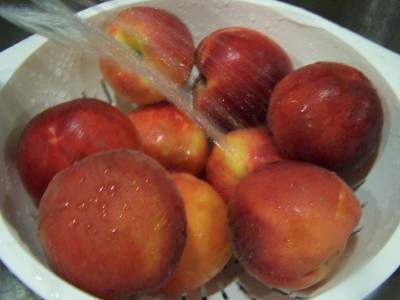 I'm
sure you can figure out how to wash the fruit in a colander of plain cold
water.
I'm
sure you can figure out how to wash the fruit in a colander of plain cold
water.
Then you need to pick out and remove any bits of stems, leaves and soft or mushy fruit. It is easiest to do this in a large bowl of water and gently run your hands through the fruit as they float. With your fingers slightly apart, you will easily feel any soft or mushy fruit get caught in your fingers.
Then just drain off the water!
Step 4 - Peeling the Peaches
Peaches and nectarines should be peeled, as their skins can be tough / chewy in jam. Peaches have such thin skins, you really don't need to peel them.
For those you want to peel, here's a great trick that works with many
fruits and vegetables with skins (like tomatoes): just dip the fruit in
boiling water for 30 to 60 seconds.
Remove from the water using a slotted spoon and put into a large bowl or pot of cold water and ice.
The skins will easily slide off now IF the peaches are ripe! The more
unripe they are, the longer you will need to heat them. You can now eat
the peaches, or
can
them or make peach jam,
etc.
For this recipe, we only need the peelings. Save all washed, sound pieces and peelings from the peaches. (if you are peeling the peaches in advance, keep the peelings refrigerated until ready to use).
I mentioned in the ingredients section that you can use canned peach juice. That's true, but it is much more difficult. The peelings add a lot of solid particulates which help the "honey" to thicken.
Step 5 - Make the juice from the peelings
Cover the peelings with water and slowly cook in a covered saucepan until they are soft. Then put in a cheesecloth bag and press to remove all juice. You may then drip the juice through a jelly bag and measure; or use the juice that was squeezed right from the cheescloth. The goal is to remove large chunks.Step 6 - Wash the jars and lids
Now's a good time to get the jars ready, so you won't be rushed later. The dishwasher is fine for the jars; especially if it has a "sanitize" cycle, the water bath processing will sanitize them as well as the contents! If you don't have a dishwasher with a sanitize cycle, you can wash the containers in hot, soapy water and rinse, then sanitize the jars by boiling them 10 minutes, and keep the jars in hot water until they are used.
Canning jars in the dishwasher NOTE: If a canning recipe calls for 10 minutes or more of process time in the canner, then the jars do not need to be "sanitized" before filling them. But really, sanitizing them first is just good hygeine and common sense! See this page for more detail about cleaning and sanitizing jars and lids.
Put the lids into a pan of hot, but not quite boiling water (that's what the manufacturer's recommend) for 10 minutes, and use the magnetic "lid lifter wand" to pull them out.
Leave the jars in the dishwasher on "heated dry" until you are ready to use them. Keeping them hot will prevent the jars from breaking when you fill them with the hot jam.
Lids: put the very hot (but not quite boiling; around 180 F, steaming water is fine)
water for at least several minutes; to soften up the gummed surface and clean the lids. I just leave them in there, with the heat on very low, until I need them!
 Need lids, rings and replacement jars?
Need lids, rings and replacement jars?
Get them all here, delivered direct to your home, at the best prices on the internet!
Step 7 - Cook
Place the juice in the saucepan and heat over medium to high heat.
When it boils vigorously, add the sugar at the rate of one-half as much
sugar as juice. Boil it down rapidly until it achieves the consistency
of honey.
If it doesn't thicken, you can mix 1/3 of a packet of pectin with 1/3 cup of sugar and mix it in. That will thicken it.
Or you can cook it down in a Crockpot overnight, on low!
Step 8 - Fill the jars and put the lid and rings on
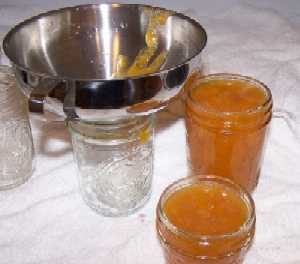 Fill
them to within 1/4-inch of the top, wipe any spilled jam off the top, seat
the lid and tighten the ring around them. Then put them into the boiling
water cann
Fill
them to within 1/4-inch of the top, wipe any spilled jam off the top, seat
the lid and tighten the ring around them. Then put them into the boiling
water cann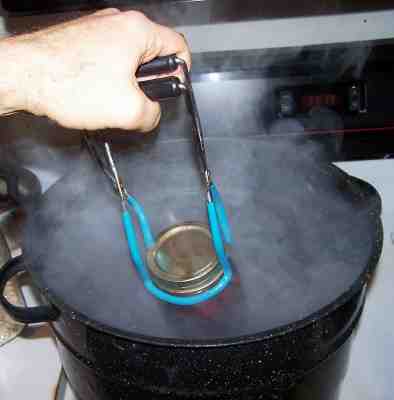 er!
er!
This is where the jar tongs and lid lifter come in really handy!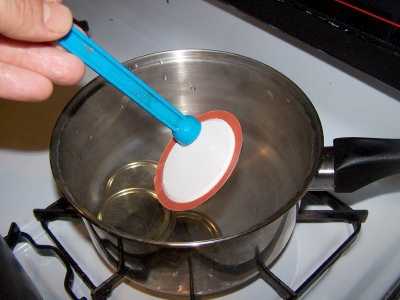
Step 9 - Process the jars in the boiling water bath
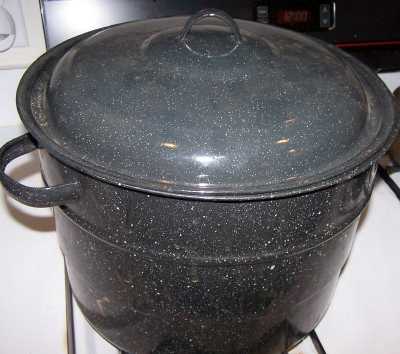 Keep
the jars covered with at least 2 inches of water. Keep the water boiling. In
general, boil them for 5 minutes. I say "in general" because you have
to process (boil) them longer at higher altitudes than sea level, or if you
use larger jars, or if you did not sanitize the jars and lids right before
using them. The directions inside every box of pectin will tell you
exactly. The directions on the pectin tend to be pretty conservative.
Clemson University says you only need to process them for 5 minutes. I
usually hedge my bets and start pulling them out after 7 minutes, and the
last jars were probably in for 10. I rarely have a jar spoil, so it
must work.
Keep
the jars covered with at least 2 inches of water. Keep the water boiling. In
general, boil them for 5 minutes. I say "in general" because you have
to process (boil) them longer at higher altitudes than sea level, or if you
use larger jars, or if you did not sanitize the jars and lids right before
using them. The directions inside every box of pectin will tell you
exactly. The directions on the pectin tend to be pretty conservative.
Clemson University says you only need to process them for 5 minutes. I
usually hedge my bets and start pulling them out after 7 minutes, and the
last jars were probably in for 10. I rarely have a jar spoil, so it
must work.
Note: Some people don't even boil the jars; they just ladle it hot into hot jars, put the lids and rings on and invert them, but putting the jars in the boiling water bath REALLY helps to reduce spoilage! To me, it makes little sense to put all the working into making the jam and then not to process the jars to be sure they don't spoil!
Step 10 - Remove and cool the jars - Done!
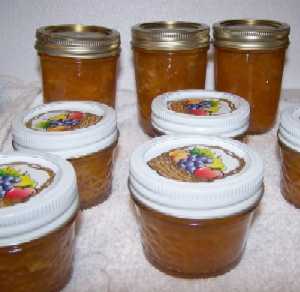 Lift
the jars out of the water and let them cool without touching or bumping
them in a draft-free place (usually takes overnight) You can then remove
the rings if you like, but if you leave them on, at least loosen them
quite a bit, so they don't rust in place due to trapped moisture. Once
the jars are cool, you can check that they are sealed verifying that the
lid has been sucked down. Just press in the center, gently, with your
finger. If it pops up and down (often making a popping sound), it is not
sealed. If you put the jar in the refrigerator right away, you can still
use it. Some people replace the lid and reprocess the jar, then that's a
bit iffy. If you heat the contents back up, re-jar them (with a new lid)
and the full time in the canner, it's usually ok.
Lift
the jars out of the water and let them cool without touching or bumping
them in a draft-free place (usually takes overnight) You can then remove
the rings if you like, but if you leave them on, at least loosen them
quite a bit, so they don't rust in place due to trapped moisture. Once
the jars are cool, you can check that they are sealed verifying that the
lid has been sucked down. Just press in the center, gently, with your
finger. If it pops up and down (often making a popping sound), it is not
sealed. If you put the jar in the refrigerator right away, you can still
use it. Some people replace the lid and reprocess the jar, then that's a
bit iffy. If you heat the contents back up, re-jar them (with a new lid)
and the full time in the canner, it's usually ok.
Once cooled, they're ready to store. I find they last up to 12 months. But after about 6 to 8 months, they get darker in color and start to get runny. They still are safe to eat, but the flavor and texture aren't as good. So eat them in the first 6 months after you prepare them!
This recipe closely follows Clemson University's lab tested peach butter recipe.
Other Equipment:From left to right:
|
 You can get all of the tools in a kit here: See here for related tools, equipment, supplies on Amazon |
Answers to Common Questions
- Can I use a combination of peelings and peach juice?
Yes! That's what I often do! You may also add pureed peaches (put them through a food processor or blender)
Comments and Feedback
- Comments from a visitor on September 07, 2011: "Just finished the peach honey. i boiled the skins for about 2 hours, ran it through my foley food mill, measured it, and I had 11 cups of juice. So I boiled it for another 1/2 hr - 45 minutes, measured it again and i only had a little over 7 cups. So I took half of the jar of peaches that didn't seal yesterday (I ate half), pureed it, and added it to the juice. Then I added the Stevia (in a prepared form like Truvia, it measures same as sugar; if you use another form, you will need do your own conversion) - or Splenda, if you prefer, and pectin. Man!! I actually licked the pot clean! Thanks again! I will do this again next year."
- Comments from a visitor on September 06, 2009: "Bought a half bushel of peaches, ~ 25 lbs. Made canned peaches, peach preserves and kept the skins for peach honey. Delicious, but only made 2.5 jars of honey, from all the skins. But thanks for this website. Really helpful to get people back to the good old ways. Thanks!"
- Comments from a visitor on September 04, 2009: "I made the peach honey today, and I must say it is fabulous! The taste is out of this world! Thanks for the recipe. "
- Comments from a visitor on July 19, 2009: "I made your recipe for peach honey yesterday. It takes a lot of time for it to boil down, but it was totally worth it! It is beautiful in the jar and tastes yummy! FYI - I made 12 1/2 pints and started with about 20 cups of juice made from peelings."
Can't find the equipment? We ship to all 50 states!
Use our Feedback form!
Canning Books, Supplies and Accessories
These are my favorite essential canning tools, books and supplies. I've been using many of these for over 50 years of canning! The ones below on this page are just the sampling of. my preferred tools. but you can find much more detailed and extensive selections on the pages that are linked below.
- Vacuum Foodsealers for freezing, dried foods, and refrigerated foods - the FoodSaver line
- Selecting a KitchenAid mixer and attachments for home canning
- Steam Juicers
- Strainers, pit removers, seed-skin-stem removers, jelly strainers, etc. All types, makes and prices (from $19 to $350)
- Cherry pitters reviews, prices and ordering
- Food dehydrators - easy and fast to dry your own fruits, veggies, sun-dried tomatoes, etc.
The All New Ball Book Of Canning And Preserving: Over 350 of the Best Canned, Jammed, Pickled, and Preserved Recipes Paperback
This is THE book on canning! My grandmother used this book when I was a child.; It tells you in simple instructions how to can almost anything; complete with recipes for jam, jellies, pickles, sauces, canning vegetables, meats, etc.
If it can be canned, this book likely tells you how! Click on the link below for more information and / or to buy (no obligation to buy)The New Ball Blue Book of Canning and Preserving
Canning and Preserving for Dummies by Karen Ward
This is another popular canning book. Click here for more information, reviews, prices for Canning and Preserving For Dummies
Of course, you do not need to buy ANY canning book as I have about 500 canning, freezing, dehydrating and more recipes all online for free, just see Easy Home Canning Directions.
Home Canning Kits
See here for related tools, equipment, supplies on Amazon See here for related tools, equipment, supplies on Amazon
I have several canners, and my favorite is the stainless steel one at right. It is easy to clean and seems like it will last forever. Mine is 10 years old and looks like new.
The black ones are the same type of standard canner that my grandmother used to make everything from applesauce to jams and jellies to tomato and spaghetti sauce.
This complete kit includes everything you need and lasts for years: the canner, jar rack, Jar grabber tongs, lid lifting wand, a plastic funnel, labels, bubble freer, It's much cheaper than buying the items separately. It's only missing the bible of canning, the Ball Blue Book.
You will never need anything else except jars & lids (and the jars are reusable)!
The complete list of canners is on these pages:
- Water bath canners - Good for acidic foods, like applesauce, pickles, salsa, jams, jellies, most fruits
- Pressure canners - needed for low and non-acidic foods, like canned vegetables (corn, green beans, etc), and meats
- Canners for glass top stoves if you have a glass or ceramic stove
- Canners for induction stovetops
Pressure Canners
If you plan on canning non-acidic foods and low acid foods that are not pickled - this means: meats, seafood, soups, green beans corn, most vegetables, etc., then you ABSOLUTELY must use a Pressure Canner.
Of course, you can use a pressure canner as a water bath canner as well - just don't seal it up, so it does not pressurize. This means a Pressure Canner is a 2-in-1 device. With it, you can can almost ANYTHING.
There are also other supplies, accessories, tools and more canners, of different styles, makes and prices, click here!
Basic Canning Accessories
From left to right:
- Jar lifting tongs to pick up hot jars
- Lid sanitizer / lifter - to remove lids from the pot of boiling water (sterilizing )
- Lids- disposable - you may only use them once
- Ring - holds the lids on the jar until after the jars cool - then you remove them, save them and reuse them
- Canning Jar funnel - to fill the jars
FREE Illustrated Canning, Freezing, Jam Instructions and Recipes
Don't spend money on books. that you don't need to. Almost everything you can find in some book sold online or in a store is on my website here for free. Start with theEasy Home Canning Directions below. That is a master list of canning directions which are all based upon the Ball Bblue book, the National Center for Home Food Preservation and other reputable lab tested recipes. Almost every recipe I present in addition to being lab tested com. is in a step by step format with photos for each step and complete. explanations. that tell you how to do it, where to get the supplies and pretty much everything you need to know. In addition, there almost always in a PDF format so you can print them out and use them while you cook.
[ Easy Home Canning Directions]
[FAQs - Answers to common questions and problems]
[Recommended books about home canning, jam making, drying and preserving!]
Looking for canning equipment and supplies?
Water bath canner with a jar rack
Pressure canners for gas, electric and induction stoves: Presto 23Qt or T-fal 22Qt
Canning scoop (this one is PERFECT)
Ball Blue book (most recent version)
Jars: 8oz canning jars for jams
Find Other types of farms:
Farm markets and roadside stands
Road trips and camping resources
Local Honey, apiaries, beekeepers
Consumer fraud and scams information
Home canning supplies at the best prices on the internet!
Maple Syrup Farms, sugarworks, maple syrup festivals
Environmental information and resources
Farms For Your Event for birthday parties, weddings, receptions, business meetings, retreats, etc.
Festivals - local fruit and vegetable festivals
Get the
most recent version of
the Ball Blue Book
With this Presto 23 quart pressure canner and pressure cooker, you can "can" everything, fruits, vegetables, jams, jellies, salsa, applesauce, pickles, even meats, soups, stews. Model 01781

You can make jams, jellies, can fruit, applesauce, salsa and pickles with water bath canners, like this Granite Ware 12-Piece Canner Kit, Jar Rack, Blancher, Colander and 5 piece Canning Tool Set





